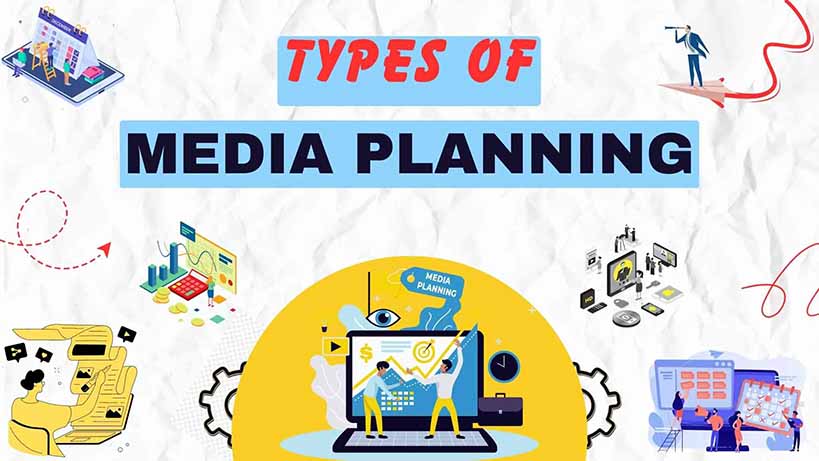What is Media Planning?
Media planning is the strategic process of determining the most effective way to deliver advertising messages to a target audience. It involves analyzing consumer behavior, market trends, and media consumption patterns to select the right combination of media channels and platforms for a successful advertising campaign. Media planners consider factors such as reach, frequency, and cost to maximize the impact of advertising efforts. They create detailed media plans that outline when and where ads should be placed to reach the target audience efficiently. By carefully planning and optimizing media resources, media planners help advertisers achieve their communication goals and maximize return on investment.
Types of Media Planning
Media planning can be broadly categorized into three types: paid media planning, owned media planning, and earned media planning. Here’s a brief explanation of each type:
1. Paid Media Planning
This type of media planning involves utilizing paid advertising channels and platforms to effectively reach the target audience. It encompasses a wide range of mediums, including traditional forms like TV, radio, print, and outdoor billboards, as well as digital channels such as display ads, search engine marketing (SEM), social media ads, and sponsored content.
For example, a company may create a TV commercial to promote their new product, placing it during popular primetime shows to capture the attention of their target audience. They may also run targeted display ads on relevant websites or use social media ads to reach a specific demographic. These paid media efforts aim to maximize reach, visibility, and engagement by strategically selecting the appropriate advertising channels and optimizing ad placements.
2. Owned Media Planning
Owned media refers to the media channels and assets that a brand or organization owns and controls. These can include websites, blogs, social media profiles, mobile apps, email newsletters, and other digital properties exclusive to the brand. Owned media planning involves creating and curating engaging content for these channels to establish direct communication with the target audience. For instance, a clothing brand may maintain an active blog featuring fashion tips, style guides, and behind-the-scenes stories. They may also leverage their social media profiles to share product updates, conduct contests, and respond to customer inquiries.
By utilizing owned media channels effectively, the brand can build brand loyalty, drive traffic to their website, and foster lasting customer relationships. It provides an opportunity for the brand to control the narrative and directly engage with their audience without the need for paid placement or distribution.
3. Earned Media Planning
Earned media refers to the publicity and exposure gained through organic or word-of-mouth channels without direct payment. It encompasses various forms such as media coverage, social media mentions, customer reviews, user-generated content, and influencer endorsements. Earned media planning focuses on creating compelling and shareable content that encourages people to talk about and promote the brand organically. It involves strategies such as engaging with customers on social media, fostering positive relationships with influencers, and implementing effective public relations tactics to generate favorable media coverage.
For example, when a new restaurant opens and receives positive reviews from food bloggers and critics, it generates earned media. Customers sharing their dining experiences on social media platforms, tagging the restaurant, and recommending it to their friends also contribute to earned media. Additionally, if the restaurant’s unique menu or ambiance catches the attention of local news outlets, resulting in a feature article, it further enhances their earned media.
Type of Media Planning | Characteristics | Examples |
Paid Media | Paid advertising channels to reach a target audience through various media channels and platforms. | TV commercials, online display ads, print ads, sponsored social media posts, influencer partnerships |
Owned Media | Brand-owned platforms for direct communication with the audience, without paying for placement or distribution. | Brand website, company blog, social media pages, branded mobile apps, email newsletters, e-books, podcasts |
Earned Media | Organic media exposure gained through third-party sources, based on the brand’s merit or newsworthiness. | News articles, press mentions, Social media shares, viral videos, customer reviews, influencer mentions, word-of-mouth referrals |
Factors involved in Media Planning
There are several factors that can affect media planning. Here are some of the key factors:
Target Audience
Understanding the demographics, preferences, and behaviors of the target audience is crucial in media planning. Different media channels and platforms appeal to different audience segments, so it’s important to choose the ones that align with the target audience.Advertising Objectives
The specific goals and objectives of the advertising campaign play a significant role in media planning. Whether the objective is to increase brand awareness, drive sales, or promote a new product, the media plan should be tailored accordingly.Budget
The available budget greatly influences media planning decisions. Different media channels have varying costs, and it’s important to allocate the budget in a way that maximizes reach and impact while staying within financial constraints.Market and Industry Trends
Staying informed about market and industry trends is crucial for effective media planning. Factors such as technological advancements, consumer behavior shifts, and competitive landscape can impact the choice of media channels and strategies.Media Consumption Habits
Understanding how the target audience consumes media is vital. Factors such as preferred media platforms, time spent on different channels, and content preferences help in selecting the most suitable media channels for reaching the audience effectively.Seasonality and Timing
Certain products or services have seasonal demand, and media planning should take into account the timing and seasonality factors. Adjusting media plans to align with peak periods or specific events can optimize campaign results.- Competitive Analysis am Analyzing the media strategies of competitors provides valuable insights and helps in identifying opportunities or gaps in the market. Media planners can then adjust their plans to differentiate their brand and maximize effectiveness.
Wrap up Tips:
Effective media planning often combines elements from all three types to create an integrated and comprehensive strategy. Integrating these media planning types allows brands to maximize their reach, engagement, and impact. Paid media drives initial awareness, owned media facilitates ongoing communication and engagement, while earned media amplifies the brand’s reach through word-of-mouth and organic advocacy. An effective media planning strategy considers the unique strengths and opportunities of each type and blends them strategically to achieve marketing objectives.
Consulting a premium ad agency like Buymediaspace for media planning can be a beneficial choice for businesses looking to optimize their advertising strategies.



